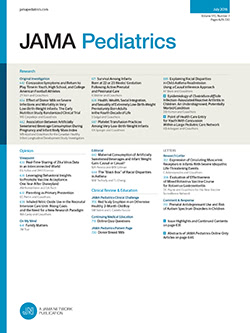New-Onset Type 1 and Type 2 Diabetes Among Korean Youths During the COVID-19 Pandemic
IF 24.7
1区 医学
Q1 PEDIATRICS
引用次数: 0
Abstract
ImportanceWhether COVID-19 contributes to youth-onset diabetes is controversial, and research in Asia is lacking.ObjectiveTo explore the incidence and severity of diabetes among youths during the COVID-19 pandemic in South Korea.Design, Setting, and ParticipantsThis cohort study used claims data for January 1, 2017, through February 28, 2022, from the National Health Insurance Service database in South Korea. The incidence of type 1 diabetes (T1D) and type 2 diabetes (T2D) in patients younger than 20 years during the pandemic was analyzed and compared with that during the prepandemic period. The study included incident cases of T1D identified by at least 2 diagnosis codes with at least 2 insulin prescriptions within 1 year and T2D identified by at least 2 diagnosis codes with at least 2 prescriptions of diabetes medication within 1 year. Analyses were performed between January 29 and September 2, 2024.ExposuresCOVID-19 pandemic and SARS-CoV-2 infection.Main Outcomes and MeasuresThe primary outcome was incidence of T1D and T2D, and secondary outcomes included the rate of diabetic ketoacidosis (DKA) and association of new-onset diabetes with SARS-CoV-2 positivity.ResultsThe study included 2599 patients with T1D (mean [SD] age, 12.0 [4.8] years; 1235 [47.5%] male) and 11 040 patients with T2D (mean [SD] age, 16.0 [2.8] years; 6861 [62.1%] male). During the pandemic, the incidence rate ratios were 1.19 (95% CI, 1.10-1.29) for T1D and 1.41 (95% CI, 1.36-1.46) for T2D. The incidence rate of DKA at diagnosis increased during the first pandemic year compared with the prepandemic period (T1D, 42.8% [95% CI, 38.5%-47.0%] vs 31.3% [95% CI, 29.0%-33.7%], respectively; T2D, 6.0% [95% CI, 5.0%-7.1%] vs 2.9% [95% CI, 2.5%-3.3%], respectively) but returned to prepandemic levels in the second pandemic year (T1D, 34.5% [95% CI, 30.6%-38.5%]; T2D, 3.2% [95% CI, 2.6%-3.9%]). The hazard ratio for new-onset diabetes associated with SARS-CoV-2 positivity was 0.44 (95% CI, 0.17-1.13) for T1D and 1.08 (95% CI, 0.74-1.57) for T2D.Conclusions and RelevanceThese findings suggest that the incidence and severity of T1D and T2D among South Korean youths increased during the COVID-19 pandemic. The cohort analysis does not support SARS-CoV-2 infection itself as being directly associated with incident diabetes.新冠疫情期间韩国青少年新发1型和2型糖尿病
COVID-19是否会导致青少年糖尿病存在争议,在亚洲也缺乏相关研究。目的了解新冠肺炎大流行期间韩国青少年糖尿病的发病率和严重程度。设计、环境和参与者本队列研究使用了2017年1月1日至2022年2月28日的索赔数据,这些数据来自韩国国家健康保险服务数据库。分析大流行期间20岁以下患者中1型糖尿病(T1D)和2型糖尿病(T2D)的发病率,并与大流行前的发病率进行比较。本研究纳入1年内至少有2个诊断码确诊为T1D且至少有2张胰岛素处方的病例,以及1年内至少有2个诊断码确诊为T2D且至少有2张糖尿病药物处方的病例。分析在2024年1月29日至9月2日之间进行。暴露于covid -19大流行和SARS-CoV-2感染。主要观察指标为T1D和T2D的发生率,次要观察指标为糖尿病酮症酸中毒(DKA)发生率和新发糖尿病与SARS-CoV-2阳性的相关性。结果本研究纳入2599例T1D患者(平均[SD]年龄12.0[4.8]岁;1235例(47.5%)男性)和11040例T2D患者(平均[SD]年龄16.0[2.8]岁;6861[62.1%]男)。大流行期间,T1D的发病率比为1.19 (95% CI, 1.10-1.29), T2D的发病率比为1.41 (95% CI, 1.36-1.46)。与大流行前相比,诊断时DKA的发病率在大流行第一年增加(T1D,分别为42.8% [95% CI, 38.5%-47.0%]和31.3% [95% CI, 29.0%-33.7%];T2D,分别为6.0% [95% CI, 5.0%-7.1%]和2.9% [95% CI, 2.5%-3.3%]),但在大流行第二年恢复到大流行前水平(T1D, 34.5% [95% CI, 30.6%-38.5%];T2d, 3.2% [95% ci, 2.6%-3.9%])。新发糖尿病与SARS-CoV-2阳性相关的T1D风险比为0.44 (95% CI, 0.17-1.13), T2D风险比为1.08 (95% CI, 0.74-1.57)。这些发现表明,在2019冠状病毒病大流行期间,韩国青少年T1D和T2D的发病率和严重程度有所增加。队列分析不支持SARS-CoV-2感染本身与偶发糖尿病直接相关。
本文章由计算机程序翻译,如有差异,请以英文原文为准。
求助全文
约1分钟内获得全文
求助全文
来源期刊

JAMA Pediatrics
PEDIATRICS-
CiteScore
31.60
自引率
1.90%
发文量
357
期刊介绍:
JAMA Pediatrics, the oldest continuously published pediatric journal in the US since 1911, is an international peer-reviewed publication and a part of the JAMA Network. Published weekly online and in 12 issues annually, it garners over 8.4 million article views and downloads yearly. All research articles become freely accessible online after 12 months without any author fees, and through the WHO's HINARI program, the online version is accessible to institutions in developing countries.
With a focus on advancing the health of infants, children, and adolescents, JAMA Pediatrics serves as a platform for discussing crucial issues and policies in child and adolescent health care. Leveraging the latest technology, it ensures timely access to information for its readers worldwide.
 求助内容:
求助内容: 应助结果提醒方式:
应助结果提醒方式:


